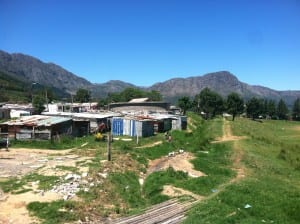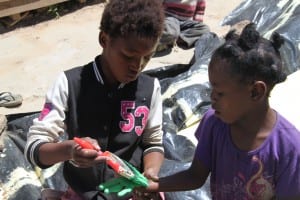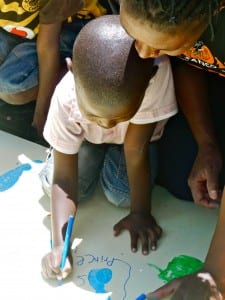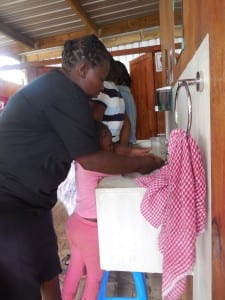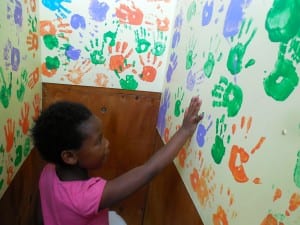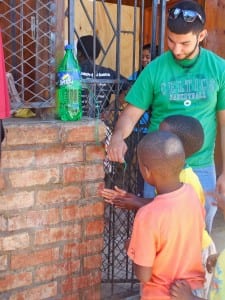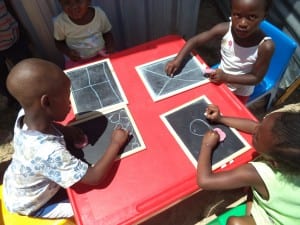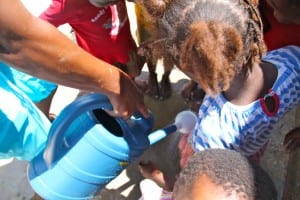Langrug: Connecting ECD with WaSH
Our work at Kiddies College Preschool was slowing down, giving us a chance to focus on the development of connections with other crèches or NGOs. One connection we made was through a team working on Water, Sanitation and Hygene (WaSH) in the informal settlement of Langrug. Recently they had been in communication with a local crèche. Ms. May, our liaison at Kiddies, joined us in our first visit to Langrug in an attempt to discover how these crèches operate. Our hope was to observe and connect with these crèches to see if and how we could help there. During this first visit to Langrug we toured five crèches and spoke with a crèche leader and community leader, Nobathembu. After this visit we then began brainstorming ways to incorporate children into the WaSH facility. As our communication with Nobathembu and the caretakers at the WaSH facility continued, we were able to discuss many areas with opportunities for improvement.
In an attempt to incorporate WaSH as a topic in the teachings throughout the crèches of Langrug, we used an idea that we found in the registration packet given to Kiddies College Preschool by the Deptartment of Social Development. Using the How-To sheet provided by the DSD, we built a mobile hand washing station with the hope that Nobathembu may like the idea and use it in her crèche. She had expressed that it was difficult for her to walk all sixty children from her crèche down to the WaSH facility, which initially led us to a way to promote WaSH in the crèche as well as in the facility.
When we realized the importance of promoting the education of WaSH, it came to our attention that it would be vital to involve the caretakers of the WaSH facility in some way. This would ensure that the children would continue to use the WaSH facility and feel comfortable connecting with the caretakers during their visits to the facility after our departure. With the help of the caretakers, we worked to make a space for children at the WaSH facility. Together we made it easier for children to access the sink, created a space for them to draw and play, and provided a way for them a fun way for them to wash their feet and legs playfully with a watering can. Also, an activity was planned and executed to upgrade the children’s toilette area at the facility with the help of the caretakers and Nobathembu. To achieve this, Nobathembu connected the local crèches and we planned a few days to paint and decorate, while using this time to better introduce the children to the WaSH facility and its many uses.
Implementations
Upgrading the Children’s Toilette Area:
The first major programme that we developed with Nobathembu was the upgrading of the children’s toilette area at the WaSH facility. Our main goals of this programme were to make a connection with the community and have an opportunity to teach the children a little more about the WaSH facility. Including the children in this process was vital in ensuring that they felt like they took part in 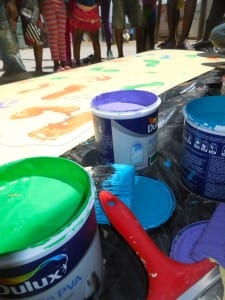 the upgrade and knew that it was being done for them. Our hope is that their involvement will keep them coming back and using the WaSH facility.
the upgrade and knew that it was being done for them. Our hope is that their involvement will keep them coming back and using the WaSH facility.
To complete this project, we first purchased and cut plywood to fit the inside of the children’s toilette stalls. With the help of Nobathembu, we painted each panel a bright yellow. Nobathembu contacted each one of the crèches in Langrug, told them about the activity, and invited them to join us to paint colourful handprints on the newly yellow panels. Two of the five crèche teachers brought down their students and we painted their hands so they could leave their hand prints on the board. Along with the crèche children, many other children of the settlement joined us in this activity each day.
During the activity we were excited to see that after the children were done painting, the caretakers took the initiative and assisted the children in washing their hands and writing their names next to their hand prints. The children quickly learned and became excited about washing their hands. A few of the older community children assisted us in helping the younger crèche children paint their hands and then wash their hands after. This was important for our project because it showed the children community involvement and commitment to our activity.
Once the two crèches and other children had participated, the boards full of hand prints were hung up and the children’s stalls. We knew our plan was successful when children flooded into the facility to find their hand print. Though the outcome of this activity was beautiful, it was the process that got many children, crèche leaders, caretakers and even some other members of the community involved and invested. We can only hope that after they have left their mark they will continue to come back to see it and use the facility to its full potential.
Hand Washing Bottles:
One thing Nobutembu has a great passion for is the hygiene of the children. She often takes her children down to the WaSH facility to clean their hands and use the toilet. However, accompanying sixty children down to the WaSH facility multiple times a day is quite a task. For the sake of children to simply wash their hands, it is not feasible for any teacher of Langrug to leave the crèche and make a trip to the WaSH facility. With the children having a snack and meals multiple times a day, it is important that they have the means to wash their hinds prior to eating. When Nobathembu expressed interest in a solution to this dilemma, we began brainstorming. We remembered that while reading through the registration packet that we received from the Department of Social Development earlier in our project time there was a mobile hand washing station that can be made very simply. After looking over the How-To sheet that we had, we built one to give Nobathembu to try out. To build the mobile hand washing station we drilled two small holes in the lid of a two liter bottle. By running one long tube through one hole, a siphon is created. To start the siphon, the bottle is squeezed with the end of the tube hanging down beyond the bottom of the bottle. A continuous flow will occur until the end of the tube is raised back above the bottle. This apparatus can be used as a basic portable tap. Nobutembu and others in Langrug can utilize this device to wash their children’s hands when they are unable to walk down to the WaSH facility.
Area for Children to Sit and Play:
A discussion with the caretakers informed us that they were trying to develop a way for children to keep themselves busy while accompanying their parents to the WaSH facility. Space being very limited inside the facility, we proposed that a table and chairs could serve as a space for children outside during the day and stored inside at night. We discussed with the caretakers the possibility of having paper and crayons or makers for the children to use, but were concerned about how the caretakers would replenish these resources one they had run out. After much brainstorming we realized that the use of chalk boards and chalk would not require as many resources while still providing a space for children and an opportunity for them to work on their fine motor skills by drawing. The table, chairs, chalkboard and chalk were successfully implemented in our time at Langrug.
Watering Can: Growing up Clean
Through brainstorming with caretakers and our project advisors, we tried to find a way to promote bathing, even if just in an informal way. Many families with children do not have the time to bring their children to the WaSH facility to pay for and use the shower every day. To allow children to use water play as an informal way of cleaning their feet, legs or faces, we introduced a garden typical watering can. Initially, this can was implemented just to see how people in the community would creatively use it. The children hopped on board right away. They filled it up and started pouring it over each other’s feet and legs, though they weren’t terribly mindful of getting their clothes wet. 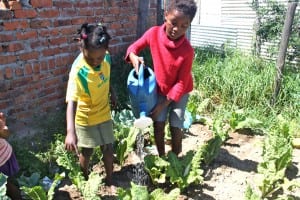 While our team observed, one of the crèche leaders who was at the WaSH facility took the watering can and all the children made a circle around her. She worked her way around the circle pouring the water over the children’s feet and legs and they scrubbed away the dirt. Once they had finished one of the small girls grabbed the can and made her way up to the community garden to begin watering the plants. Though this obvious use had not occurred to us in our planning, we were delighted to see that this watering can would be used in multiple ways throughout the community. We hope that the use of this watering can will be continued after our departure from Cape Town.
While our team observed, one of the crèche leaders who was at the WaSH facility took the watering can and all the children made a circle around her. She worked her way around the circle pouring the water over the children’s feet and legs and they scrubbed away the dirt. Once they had finished one of the small girls grabbed the can and made her way up to the community garden to begin watering the plants. Though this obvious use had not occurred to us in our planning, we were delighted to see that this watering can would be used in multiple ways throughout the community. We hope that the use of this watering can will be continued after our departure from Cape Town.
Accessible Sink for Children:
One of the ways in which we wanted to create a clear presence of children in the WaSH facility was by making it possible for children to wash their hands independently. There had been talk of a low level sink especially for children, but due to time and space constraints we were not able to implement that during the course of our project. However, we were able to create a simple solution for the time being by purchasing a small stool. The stool is store just under the sink and the child can slide it out and use it to access the sink and soap dispenser. Though it was a very small and simple change, we were happy to make this improvement to promote independent hand washing for children.
Developing Ideas for the Future
With our project time in Cape Town being so short, many of the ideas we hoped to implement could not be applied in Langrug. We were able to implement some of the short term ideas we had, but not all of the long term projects. With this in mind, we have developed a series of eight opportunities for improvement that can be discussed and acted upon by future groups of the Cape Town Project Centre. To view outlines of the opportunity possibilities, click here.



